Since the beginning of the year, the Federal Reserve has been heavily discussing, warning rather, they were going to begin to “unwind” their gargantuan balance sheet. As Michael Lebowitz recently penned in his subscription-only article “Draining The Punchbowl:”
“Since QE was first introduced, the S&P 500 has gained 1,546 points. All but 355 points were achieved during periods of QE. Of those remaining 355 points, over 80% occurred after Trump’s victory.”
That is a pretty amazing set of stats. I have previously noted the high correlation of the financial markets relative to the ongoing liquidity operations of the Federal Reserve. I have updated that analysis to show the reduction in the balance according to the Fed’s proposed schedule.
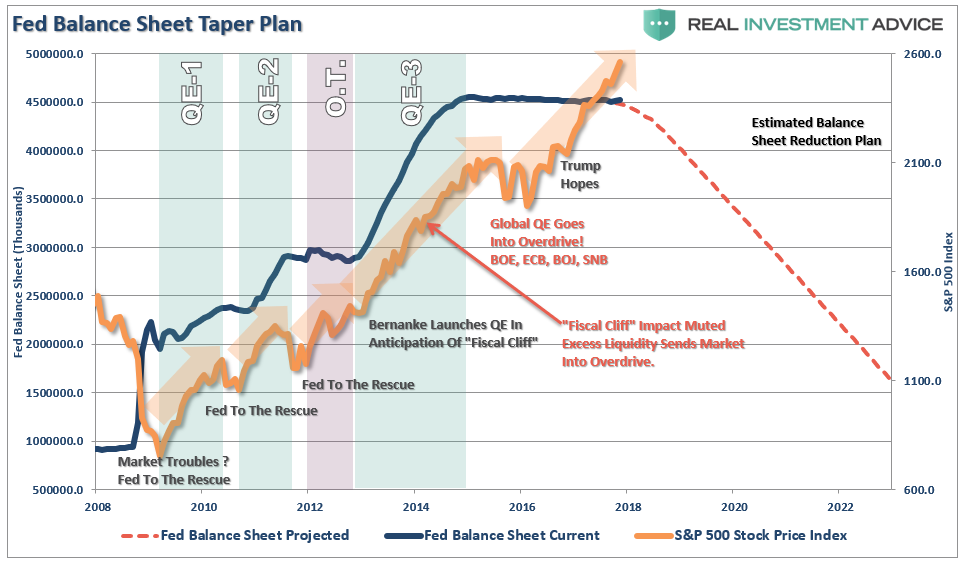
While the market stumbled following the end of QE in the United States, global QE, as shown in the charts of the major global Central Banks picked up the slack.
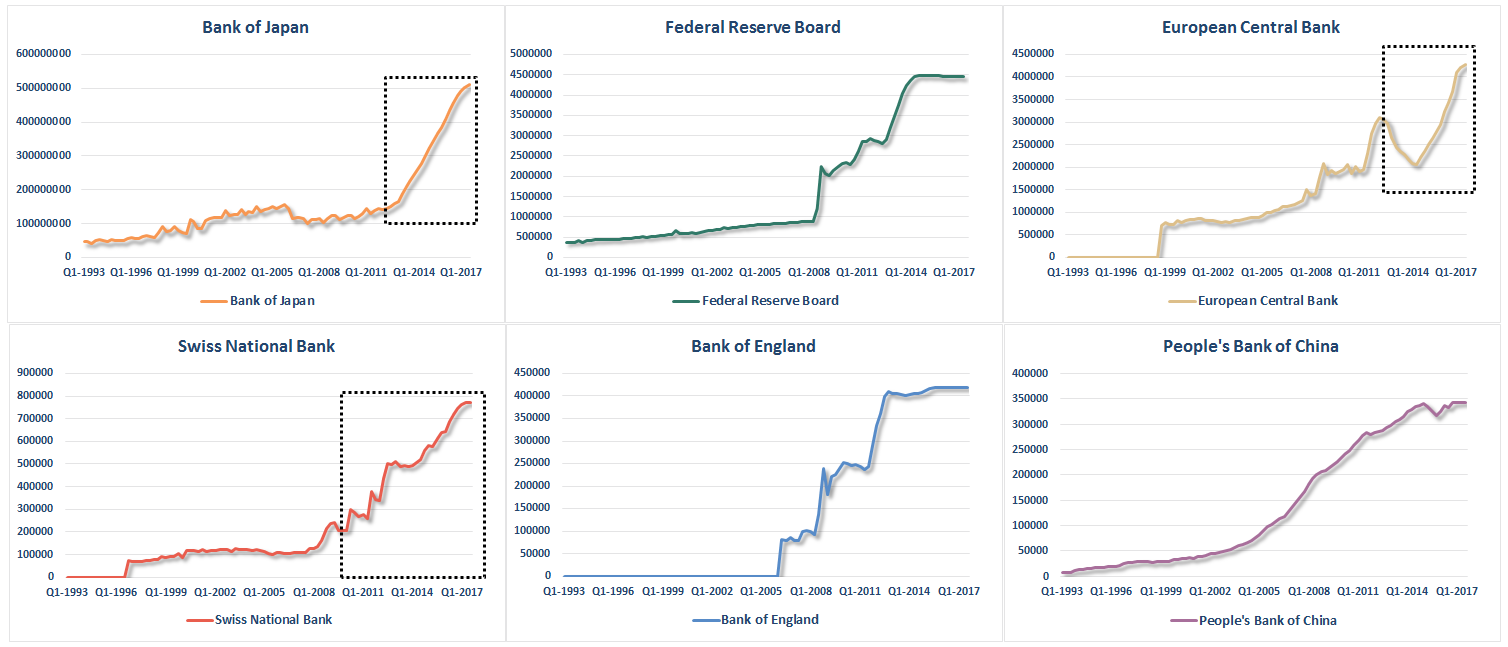
But now, the ECB has already begun discussing their plans to begin cutting the amount of their QE program by half in the coming year.
“European Central Bank officials are considering cutting their monthly bond buying by at least half starting in January and keeping their program active for at least nine months, according to officials familiar with the debate.
Reducing quantitative easing to 30 billion euros ($36 billion) a month from the current pace of 60 billion euros is a feasible option, said the officials, who asked not to be identified because the deliberations are private. That reduced flow would match existing predictions from economists at institutions including ABN Amro Bank NV and Bank of America Merrill Lynch.”
The hope, of course, by Central Bank officials is that global economies are now humming along at a pace strong enough to withstand the reduction of “emergency measures.” Of course, the real question is whether the Central Bank’s “measures” of economic strength are accurate. While there are certainly indicators such as GDP growth, production, and employment measures which suggests that global economies are indeed on a cyclical upswing, there are also numerous measures which suggest the opposite.
“The Fed understands that economic cycles do not last forever, and we are closer to the next recession than not. While raising rates will accelerate a potential recession and a significant market correction, from the Fed’s perspective it might be the ‘lesser of two evils.’ Being caught near the ‘zero bound’ at the onset of a recession leaves few options for the Federal Reserve to stabilize an economic decline.”
With the Fed trying to raise interest rates, and reduce the balance sheet simultaneously, the “tightening of monetary policy” is a drag on economic growth and ultimately the stock market. But as I stated above, while the Fed is currently “discussing” the reduction of their balance sheet beginning in October, they actually haven’t. In fact, just last week the Fed increased their balance sheet by over $13.5 billion dollars. No wonder the stock market shot higher.
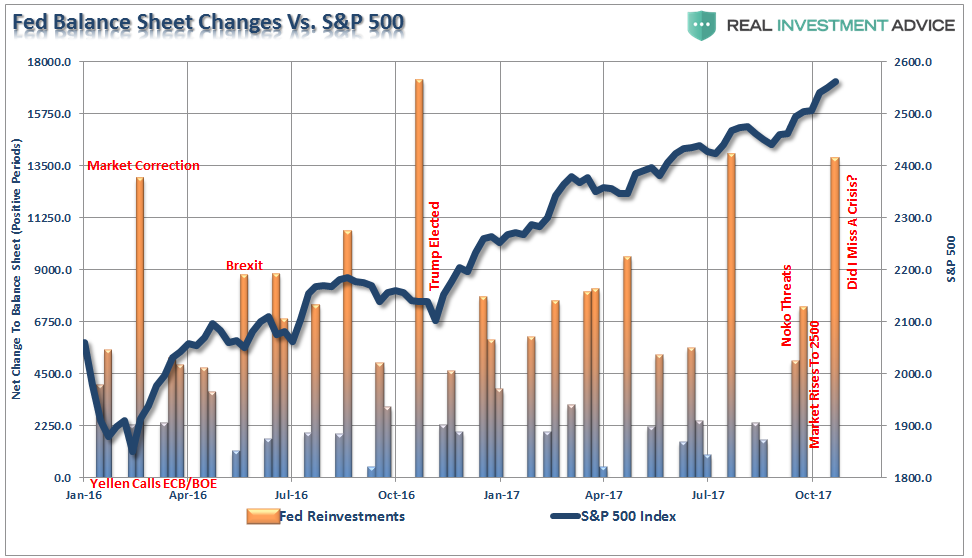
Since these balance sheet expansions generally have occurred at points where asset prices were at risk due to some “event,” the latest expansion occurred during the “tax cut hope” driven rise. The raises the potential question of:
“What does the Fed know that we don’t.”
Wolf Richter recently proposed 5-possible conclusions to extract from the Fed’s actions:
- The whole QE-unwind announcement was a hoax to test how stupid everyone is. But I doubt this.
- The people running the OMO are on vacation and have been replaced by algos or interns, and they just keep doing what the folks now on vacation have been doing for years. I doubt this too.
- The FOMC told the public what it wants to have done but forgot to tell its own people at the Trading Desk. I doubt that too.
- There is willfulness in it – a sign that they’re not ready, or that they want to give the markets more time to get used to the idea of it, etc. And this could be the case.
- They’re seeing something that worries them, and they’re holding off for now to get a clearer picture. But I doubt this because their decision to commence the QE-unwind on October 1 was unanimous, and since then nothing of enough enormity has changed.
While Wolf doubts the 5th point. I don’t as much. The reason I say that is because the yield curve seems to be sniffing out something.
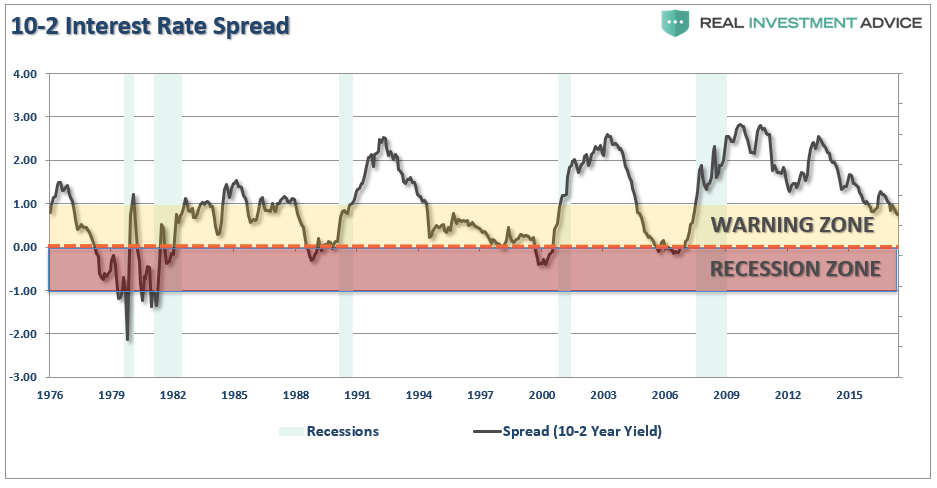
Given current market valuations, exceedingly low yields on junk bonds globally, complacency elevated along with very high levels of both bullish sentiment and heavy investor equity allocations, the risk of a “policy related” error is extremely high.
The “Bond Bull” Ain’t Dead…It’s Just Resting
The recent “pop” in rates, after declining to near 2% this summer, has once again brought calls for the end of the “bond bull.” These calls have been, for the last 4-years, prime buying opportunities to add bond exposure to portfolios. The recent rise in rates came with the election of President Trump and hopes for “tax cuts and reforms.” Theoretically, these policies will boost economic growth and inflation as seen during the Reagan era leading to higher rates for bonds. However, as discussed previously, given the completely inverted state of economic dynamics, there is a high probability these reforms will fail to create the economic growth boost currently hoped for. (That is even if they come to fruition.)
But the Fed’s balance sheet reduction is also suggestive of lower, not higher, interest rates. In the past, despite what the Fed suggested would happen, rates rose during their QE programs as money rotated out of the “safety of bonds” back into equities. When those programs ended, rates fell. Rates also fell to lows after the end of QE, and despite the “Trump Bump” since the election, the further reduction of liquidity, and potential onset of a recession in the months ahead, will likely lead to a significant push lower as money rotates from “risk” back to the “safety” of U.S. Treasuries.
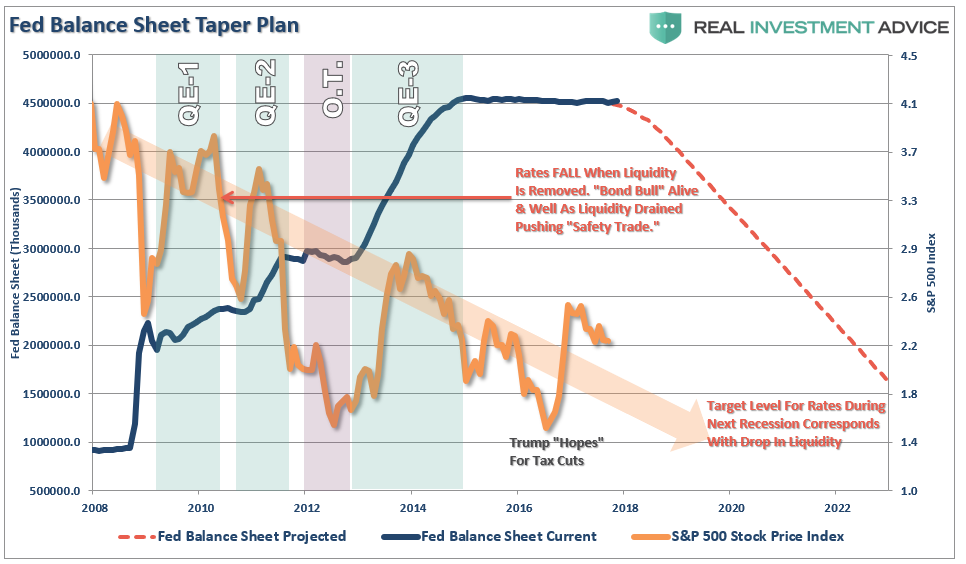
As I laid out previously:
“There is an assumption that because interest rates are low, that the bond bull market has come to its inevitable conclusion. The problem with this assumption is three-fold:
- All interest rates are relative. With more than $10-Trillion in debt globally sporting negative interest rates, the assumption that rates in the U.S. are about to spike higher is likely wrong. Higher yields in U.S. debt attracts flows of capital from countries with negative yields which push rates lower in the U.S. Given the current push by Central Banks globally to suppress interest rates to keep nascent economic growth going, an eventual zero-yield on U.S. debt is not unrealistic.
- The coming budget deficit balloon. Given the lack of fiscal policy controls in Washington, and promises of continued largesse in the future, the budget deficit is set to swell back to $1 Trillion or more in the coming years. This will require more government bond issuance to fund future expenditures which will be magnified during the next recessionary spat as tax revenue falls.
- Central Banks will continue to be a buyer of bonds to maintain the current status quo, but will become more aggressive buyers during the next recession. The next QE program by the Fed to offset the next economic recession will likely be $2-4 Trillion which will push the 10-Year yield towards zero.”
In this past weekend’s missive “Yellen Speaks Japanese” and yesterday’s post “Debt, Deficits & Economic Warnings” I laid out the data constructs behind the points above.
With Yellen pushing the idea of more government spending, the budget deficit already expanding and economic growth running well below expectations, the demand for bonds will continue to grow. However, from a technical perspective, the trend of interest rates already suggest a rate of zero during the next economic recession.”
Here is the point, while the punditry continues to push a narrative that “stocks are the only game in town,” this will likely turn out to be poor advice. But such is the nature of a media-driven analysis with a lack of historical experience or perspective.
From many perspectives, the real risk of the heavy equity exposure in portfolios is outweighed by the potential for further reward. The realization of “risk,” when it occurs, will lead to a rapid unwinding of the markets pushing volatility higher and bond yields lower. This is why I continue to acquire bonds on rallies in the markets, which suppresses bond prices, to increase portfolio income and hedge against a future market dislocation.
In other words, I get paid to hedge risk, lower portfolio volatility and protect capital. Bonds aren’t dead, in fact, they are likely going to be your best investment in the not too distant future.
In the short-term, the market could surely rise further, especially if the Fed continues reinvesting the proceeds from their balance sheet. This is a point I will not argue as investors are historically prone to chase returns until the very end. But over the intermediate to longer-term time frame, the consequences are entirely negative.
As my mom used to say:
“It’s all fun and games until someone gets their eye put out.”
